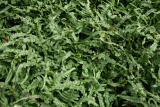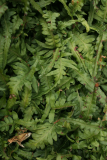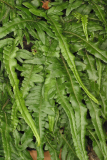Additional notes (click to expand)
Medicinal
Liquorice fern was employed medicinally by several native North American Indian tribes who used it especially as a treatment for a variety of chest complaints. It is little, if at all, used in modern herbalism. The rhizomes are alterative, carminative, haemostatic and pectoral. The raw rhizomes have been eaten, or an infusion has been used, in the treatment of coughs and colds, chest pains, shortness of breath and VD. The roots have been chewed, and the juice swallowed, as a treatment for sore throats and the spitting or vomiting of blood[ Moerman. D. Native American Ethnobotany Timber Press. Oregon. 1998]. A tea of the pounded boiled rhizomes, mixed with fir needles, has been used to treat measles. Coughs have been treated by chewing and slowly swallowing the juice of the roasted rhizome[Weiner. M. A. Earth Medicine, Earth Food. Ballantine Books 1980]. The roots have been used in the treatment of colds and sore throats[Turner. N. J. Food Plants of Coastal First Peoples UBC Press. Vancouver. 1995].
https://pfaf.org https://pfaf.org/User/Plant.aspx?LatinName=Polypodium+glycyrrhiza
Geographical distribution
- Northern America
Polypodium glycyrrhiza D.C.Eaton 'Longicaudatum'
Family: POLYPODIACEAEGenus: Polypodium
Species: glycyrrhiza D.C.Eaton
Cultivar: 'Longicaudatum'
Common names: Licorice Fern
Distribution summary: Garden origin
Habit: Perennial
Hardiness: H5 - Hardy; cold winter
Garden status: Currently grown
Garden location: North America (A)
Reason for growing: Medicinal
.JPG)

.JPG)

